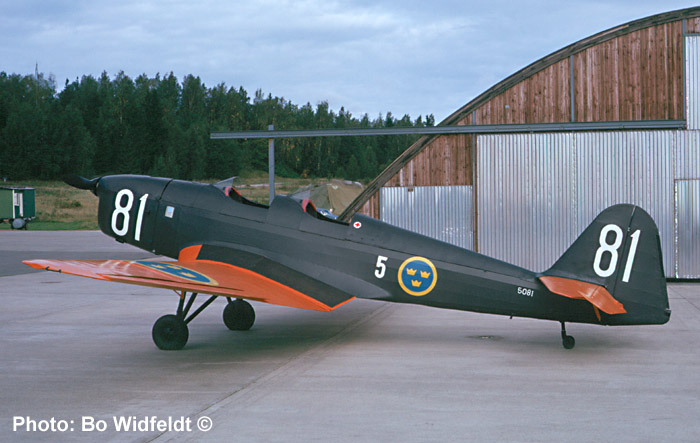|
|
||
|
Sk
15 - Klemm Kl 35
(1940-1949) |
||
|
|
Page 1 (2) |
|
|
|
||
 |
||
|
Hans Klemm was fifty years old when he designed the aircraft which the
German RLM (Ministry of Aviation) later designated as ”Klemm Kl 35”.
Hans Klemm was an experienced aircraft engineer, who, after working with
airships at Zeppelin Luftschiffbau, was employed by several leading
German aircraft manufacturers during the interwar period. Not that Klemm was popular at RLM -
he had difficulties when he started an aircraft production of his own.
The new clandestine German Luftwaffe did not see any use of Klemm’s
light aircraft. Hermann Göring even once stated that Klemm’s ”paper
aeroplanes” were unnecessary. But Hans Klemm did not give up. A morning in February 1935, a Klemm 35
took to the air for the first time. Klemm’s chief test pilot Helmut
Kalkstein flow the sleek, beautiful aircraft which behaved itself
excellent when he tried aerobatics. The typical inverted gull wing gave
the pilot a good view and also gave the aircraft its typical appearance.
The Klemm Kl 35 was a low-winged aircraft with self-supporting wings,
entirely built of wood and covered with ply. The aircraft had two
cockpits in tandem, with the pilot in the aft one. The fuselage was
constructed as a steel framework, covered with fabric. The Germany WWI ace Ernst Udet, later promoted to full General by
Hermann Göring, become very impressed by the new Klemm aircraft. With
the support of Udet, Kl 35 was ordered by the Lufwaffe in quantities.
The aircraft was also exported to several countries. The Klemm 35 also reached Sweden. 24 civil Kl 35’s were imported to
Sweden before and during the WWII. In the Swedish aviation press, the
Klemm 35 was described as ”Superb land- and sea machines suitable for
tourist- training- and sport aviation”. Fourteen of the civil Swedish
Klemms (Kl 35B) were mobilized by the Air Force and was provided to the
Auxiliary Flying School. Their military designation become Sk 15. The aircraft was repainted to the Air Force standard painting
and markings. The Air Force found the performance of the mobilized Kl 35:s very good,
and 74 Klemm Kl 35D’s were
ordered in 1940. A fast delivery was granted, which was necessary as the
need of trainers was acute. The mobilized KL 35’s got, as mentioned
above, the designation Sk 15.
The 74 aircraft purchased directly by the Air Force were of three
different variants:
-
Sk 15A
- 64 aircraft with tripod landing gears. These aircraft were used for
basic training. - Sk 15B -
Five aircraft with built-in cockpits an extra fuel tank, used as
staff aircraft.
-
Sk 15C
- Five aircraft which could be fitted with floats. They had a larger
propeller than the other variants. Most of the trainers were provided to the
Air Force Flight Academy (F 5) at
Ljungbyhed. When the Sk 15 was replaced by Sk 25 Bücker Bestmann, the
Klemms were sold to the civil market, where many were used as tugs for
siailplanes. Photos: Top - Sk 15 # 5081 (c/n 1692), at the Central Workshops at Västerås (CVV) in September 1966. This aircraft was from the beginning in the civil register as SE-AKD, but was mobilized by the Air Force in 1940. Below: Sk 15C # 5069 (c/n 1904) of Wing F 2, Hägernäs fitted with floats. The aircraft in the background is a SAAB B 17BS. A rare photo, taken at Leksand, from the large archive of Lars E. Lundin, Västervik. Bottom: - Sk 15 # 5075 (c/n 1596, earlier SE-AIG, mobilized in 1939), exhibited at Flygvapenmuseum. The Klemm Kl 35 was powered by a Hirth HM 504-A2 4-cylinder air-cooled
engine which delivered 105 hp. Length: 7,41 m. Span: 10,40. MTOW: 850 kg. Max. speed: 212 km/h.
|
||
 |
||
 |
||
|
|
||
|
|
||
|
|
||
|
© Lars Henriksson |
|
Updated 2010-07-10 |
|
|
||